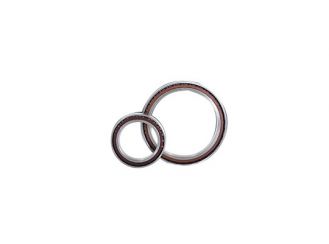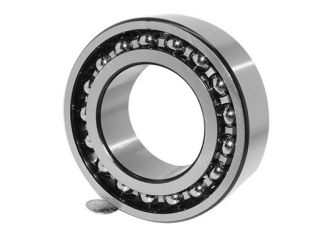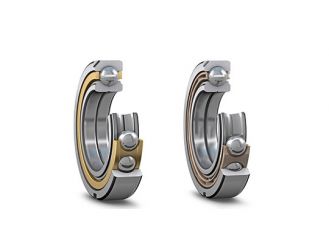


Angular contact ball bearing
Angular contact ball bearings are specially applied to the combined radial and axial loads and their limit speeds are very high.
The axial load capacity of such bearing depends on the size of contact angle, namely the larger the contact angle, the greater the axial load capacity.
According to the number of rows, there is single row angular contact ball bearing, double row angular contact ball bearing and four point contact ball bearing.
(1) Single row angular contact ball bearing
Single row angular contact ball bearings can carry the axial load in a particular direction. The axial load capacity is determined by its contact angle α, namely the greater the contact angle α, the larger the axial carrying capacity. The contact angles commonly used are 15°, 25° and 40° respectively.
The contact point of such bearing is not at the bottom of the raceway, so when such bearing carries radial load, a certain axial force will be produced and the inner and outer rings will be removed, and so it should be used in pairs. Because the number of balls is not limited by the filling angle, compared with the deep groove ball bearing, its number of steel balls is more, and so the rigidity is better and the carrying capacity is higher.
This kind of bearing is divided into two types: separable bearing and inseparable bearing.
The separable bearing is divided in two types: type S70000 and type SN70000 with inner and outer rings separable respectively. The inner and outer rings can be installed separately, so this kind of bearing is suitable for condition in which the space of the installing site is limited.
The inseparable angular contact ball bearing has the following three structures :
♦ α=15°,70000 C ;
♦ α=15°, type 70000 C ;
♦ α=25°,70000 AC ;
♦ α=25°, type 70000 AC ;
♦ α=40°,70000 B ;
♦ α=40°, type 70000 B ;
Single row angular contact ball bearings use generally metal solid cages. Under high speed operation, the solid cage of phenolic resin material is generally used, and the temperature used is not more than 120 ℃.
(2) Double row angular contact ball bearing
The design of double row angular contact ball bearing is almost the same as that of single row angle contact ball bearing, but its axial dimension is relatively smaller. A double row angular contact ball bearing is equivalent to two single row bearings installed back to back. Double row bearing can carry axial load in two directions and moment load.
The angle of inclination between inner ring and outer ring of double row angular contact ball bearing is limited. The maximum allowable angle of inclination is determined by the internal clearance of the bearing, the structural design of the bearing, and the force and moment acted on the bearing. The excessive angle of inclination between inner ring and outer ring will lead to the decrease of rotating accuracy of the bearing and the increase of the noise, which will lead to premature failure of the bearing. For details, please consult E-FINE engineer.
Main structural features: it can carry both axial force and radial force and is suitable for high speed operation.
The double row angular contact ball bearings produced by E-FINE Company in recent years are applied to the thrust end of the work roll of high speed mill and have the characteristics of stable rotation and long life.
(3) Four point contact ball bearing
Four point contact ball bearings are separable bearings, generally including two structures: type QJ 0000 -- two-piece inner ring and an integral outer ring; type QJF 0000 -- two-piece outer ring and an integral inner ring. The contact angle is usually 35°. Under the pure radial load, the steel ball and the raceway are in four-point contact. Under the unidirectional axial load, the steel ball and the raceway are in two-point contact. This kind of bearing can carry axial load in two directions and eccentric load, namely moment load. It has the characteristics and performance of single row and double row angular contact ball bearings. If used under high speed operation, two-point contact must be ensured to ensure its normal operation.
Address:No. 436, Longmen Avenue, Luolong District, Luoyang City, Henan Province, China
Tel:+86-13837910731 E-mail: sale@lyefinebearing.com Wechat : +86-13837910731